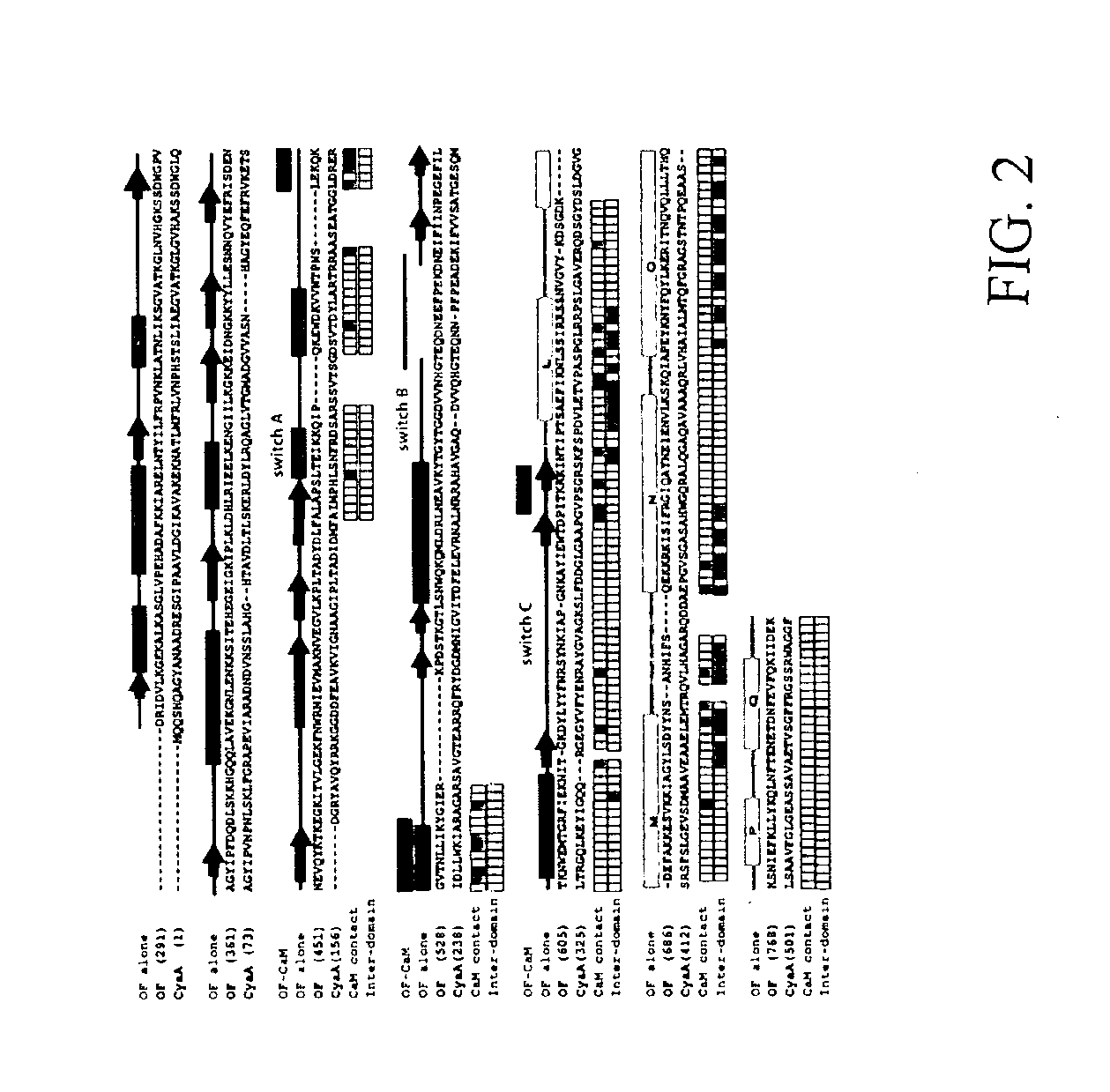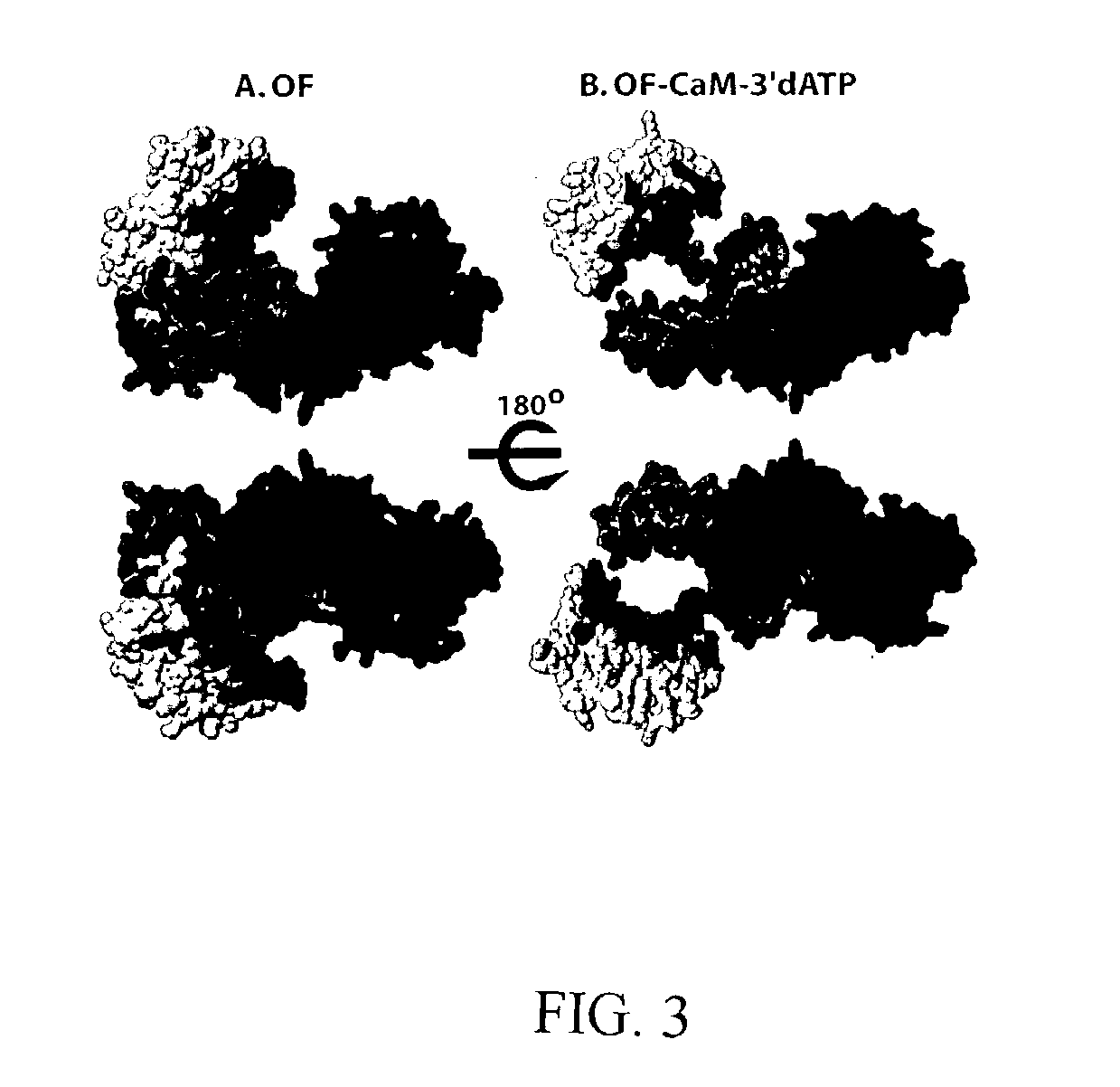Methods and compositions relating to anthrax pathogenesis
a technology of anthrax and pathogenesis, applied in the field of crystallized edema factor, can solve the problems of ineffective fighting of such infections, many antibiotics can be ineffective in preventing such infections, and immunocompromised patients, etc., to inhibit the pathogenesis of bacterial infections
- Summary
- Abstract
- Description
- Claims
- Application Information
AI Technical Summary
Benefits of technology
Problems solved by technology
Method used
Image
Examples
example 1
General Description of the EF structure with and without CaM
[0093]The structure of EF-CaM at 2.75 Å resolution was solved using selenomethionine multiple wavelength anomalous diffraction (MAD) in conjunction with conventional heavy atom methods (Drum et al., 2001) (Table 1). The structure of EF without CaM or substrate at 2.6 Å resolution was solved by molecular replacement using the catalytic core domains of EF-CaM / 3-d′ATP as the model. Crystals of the EF-CaM complex in the absence of the nucleotide substrate were isomorphous with those of the 3′-dATP-bound CaM complex. The R-factors for EF alone, EF-CaM-3′dATP, and EF-CaM are 22.8%(Rfree=27.6%), 21.5%(28.6%), and 27.8%(31.5%), respectively.
TABLE 1Crystallographic and refinement statisticsA. Crystallographic dataCrystalEF3-CH6-CaM-H6-EF3EF3-CH6-CaM3′dATPSpace groupI222P21212I222a117.6050.47116.73b167.44203.60167.31c343.4874.03344.30X-Ray sourceAPS, 14-BM-CAPS, 14-BM-CNSLS X-25Resolution (Å)2.752.62.95completeness (%)91.6 (57.2)98.5...
example 2
Geometry of the Active Site of EF-CaM Complex
[0096]3′dATP, a non-cyclizable substrate analog, is clearly visible in simulated annealing omit maps of the EF-CaM-3′dATP structure (supplemental material). Residues from six segments of the protein form the substrate-binding pocket (FIG. 5A). These residues form a network of hydrogen bonds and ionic interactions, which completely encircle the triphosphate and ribose moieties, forming an enclosed cavity with openings at both ends (FIG. 5A). The most notable phosphate interactions are made by K346, which contacts oxygens from all three phosphates; R329, which interacts with the β-phosphate; and K372 and S354, which interact with the γ-phosphate (FIG. 5A). F586 and L348 lie above and below the plane of the ribose, and the side chain of N583 forms a hydrogen bond with O4′ of the ribose ring. The adenosine ring, though solvent accessible, contacts the backbone of D582 and N583, and the N6 nitrogen is within hydrogen bonding distance of the ma...
example 3
Comparison of EF and Mammalian Adenylyl Cyclase
[0099]Four genetically unrelated groups catalogue all known adenylyl cyclases. While the catalytic core structures of mAC and ESAG from Trypanosoma brucei (class III, the family of adenylyl cyclases from bacteria to mammals (Tang and Hurley, 1998) have been determined crystallographically (Tesmer et al., 1997; Bieger and Essen, 2001), EF represents the first member of the adenylyl cyclase toxin family (class II) to be structurally characterized. Comparison of these two classes reveals no obvious structural homology (FIG. 5D). Whereas the catalytic portion of the mammalian enzymes is composed of two similarly folded domains, C1a and C2a, with rough two-fold symmetry; EF, which functions as a soluble monomer, has no such symmetry. Superimposing the ATPaS nucleotide from mAC with the 3′dATP nucleotide seen in EF-CaM reveals that despite a lack of overall structural homology, there are residue-level similarities in substrate binding and cat...
PUM
| Property | Measurement | Unit |
|---|---|---|
| exposure time | aaaaa | aaaaa |
| apparent dissociation constant | aaaaa | aaaaa |
| pH | aaaaa | aaaaa |
Abstract
Description
Claims
Application Information
 Login to View More
Login to View More - R&D
- Intellectual Property
- Life Sciences
- Materials
- Tech Scout
- Unparalleled Data Quality
- Higher Quality Content
- 60% Fewer Hallucinations
Browse by: Latest US Patents, China's latest patents, Technical Efficacy Thesaurus, Application Domain, Technology Topic, Popular Technical Reports.
© 2025 PatSnap. All rights reserved.Legal|Privacy policy|Modern Slavery Act Transparency Statement|Sitemap|About US| Contact US: help@patsnap.com



